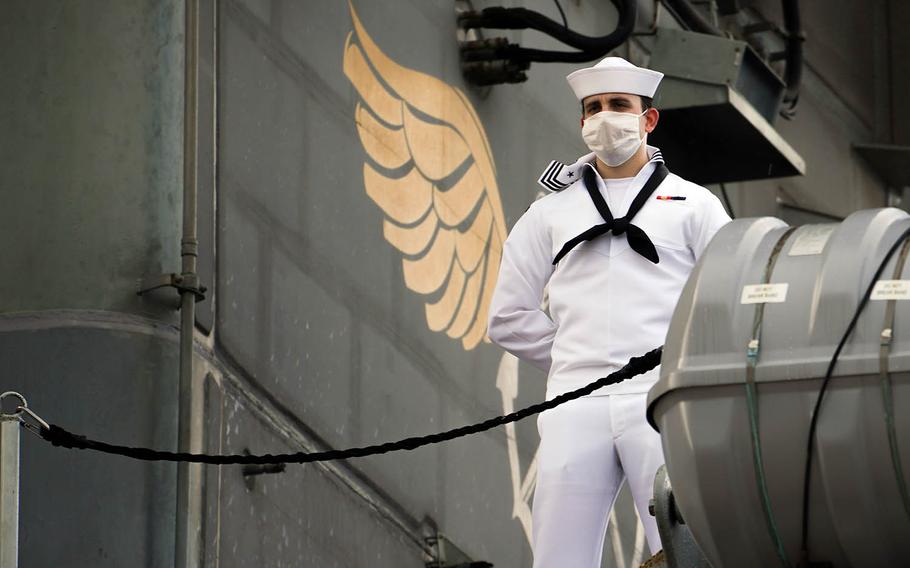
A sailor mans the rails aboard the USS Theodore Roosevelt as the aircraft carrier prepares to depart Naval Base Guam, June 4, 2020. (Kelsey Hockenberger/U.S. Navy)
Stars and Stripes is making stories on the coronavirus pandemic available free of charge. See other free reports here. Sign up for our daily coronavirus newsletter here. Please support our journalism with a subscription.
An urgent appeal to superiors by the former commander of the USS Theodore Roosevelt to transfer sailors infected by a coronavirus outbreak aboard the carrier in March was well founded, according to a study published Thursday by an American Medical Association journal.
The virus tore through the ship’s crew of roughly 4,800 sailors in the weeks after leaving port from Danang, Vietnam, early that month. After docking in Guam on March 25, Capt. Brett Crozier urged his superiors to clear the ship to prevent the spread of disease because it was not possible to adequately quarantine and maintain physical distance while aboard.
Crozier was fired after a letter he sent to Navy higher-ups asking for help surfaced in the San Francisco Chronicle soon after.
The authors of the JAMA Network Open study, members of the U.S. Army Public Health COVID-19 Task Force, concluded that the act of isolating and quarantining hundreds of sailors on the island dramatically interrupted the acceleration of the outbreak.
“[T]he rapid increase in case [numbers] as incubating cases disembarked, followed by the precipitous decrease in cases, suggests that the shore-based nonpharmaceutical interventions interrupted a probable acceleration in case incidence that would have likely resulted in a substantial disease burden,” the study concluded.
Roosevelt’s outbreak peaked March 30 with 30 new infections. Infected sailors began being moved off the ship the next day for isolation at Naval Base Guam. Roughly a quarter of the ship’s crew were ultimately infected during the outbreak.
The carrier departed Guam on June 4, although some sailors were left behind to complete their recovery.
In the study, researchers analyzed data from all 736 Roosevelt sailors who were diagnosed with the coronavirus and placed in isolation between March 31 and April 15.
Roughly 80% of those sailors exhibited symptoms, while the remaining 146 had no symptoms during the study period.
Six sailors were hospitalized, and one died.
The number of new infections plummeted within a few days of the sailors disembarking, with only one to three daily new cases being reported after April 4.
That quick short-circuiting of the outbreak seems to affirm Crozier’s conclusion that the ship should be cleared immediately.
Crozier had sent a message to a handful of Navy admirals and captains on March 30 with a plan to remove most of the crew. The message was leaked to the media, and Acting Secretary of the Navy Thomas Modly relieved Crozier of command after it was published.
Modly flew to Guam, where he addressed the Roosevelt crew — who had expressed support for their former captain — and described Crozier as “too naïve or too stupid to be a commanding officer.”
Caught up in the backlash to the firing and the speech, Modly resigned.
In a commentary published beside the JAMA study, Dr. John D. Malone of San Diego County’s Epidemiology and Immunization Services Branch lamented that the hard lessons learned from the Roosevelt outbreak will remain overshadowed by the high-profile firing and resignation.
“Masks, hand hygiene, and social distancing when possible are beneficial but will not change the basic issues with closed, confined-space environments and forced linear air handling systems,” Malone wrote of the challenges in controlling viral spread aboard ships.
“Unfortunately, the COVID-19 outbreak on the USS Theodore Roosevelt will be remembered by the removal of the Commanding Officer and April 7, 2020, resignation of the Secretary of the Navy instead of the many lessons learned regarding a highly contagious respiratory virus in ships with closely confined spaces and linear airflow systems,” he wrote.
olson.wyatt@stripes.com Twitter: @WyattWOlson